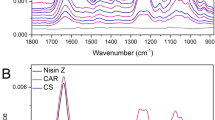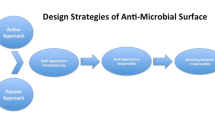Abstract
The efficacy of the antimicrobial peptide nisin was examined after adsorption to silica surfaces. Three protocols were used to evaluate nisin's activity against adhered cells ofListeria monocytogenes: bioassay usingPediococcus pentosaceous FBB 61-2 as the sensitive indicator strain; visualization and enumeration of cells by microscopic image analysis; and viability of adhered cells as determined by lodonitrotetrazolium violet uptake and crystallization. The activity of adsorbed nisin was highly dependent upon conditions of adsorption. The highest antimicrobial activity of adsorbed nisin occurred with high concentrations of nisin (1.0 mg ml−1) and brief contact times (1 h) on surfaces of low hydrophobicity. Sequential adsorption of a second protein (β-lactoglobulin or bovine serum albumin) onto surfaces consistently resulted in decreased nisin activity. These data provide direction for the development of applications to limit microbial attachment on food contact surfaces through the use of adsorbed antimicrobial peptides.
Similar content being viewed by others
References
Absolom DR, FV Lamberti, Z Policova, W Zingg CJ van Oss and AW Neumann. 1983. Surface thermodynamics of bacterial adhesion. Appl Environ Microbiol 46: 9097.
Al-Makhlafi H, J McGuire and M Daeschel. 1994. The influence of preadsorbed milk proteins on adhesion ofListeria monocytogenes to hydrophobic and hydrophilic silica surfaces. Appl Environ Microbiol 60: 3560–3565.
Arai T and W Norde. 1990. The behavior of some model proteins at solid-liquid interfaces. 2. Sequential and competitive adsorption. Colloids Surf 51: 17–28.
Barnes, R, P Archer, J Strack and GR Istre. 1989. Listeriosis associated with consumption of turkey franks. Morbid Mortal Weekly Rep 38: 267–268.
Benkerroum N and WE Sandine. 1988. Inhibitory action of nisin againstListeria monocytogenes. J Dairy Sci 71: 3237–3245.
Benz R, G Jung and HG Sahl. 1991. Mechanism of channel-formation by lantibiotics in black lipid membranes. In: Nisin and Novel Lantibiotics (Jung G and HG Sahl, eds), pp 359–372, Escom Science Publishers, Leiden, Netherlands.
Bille J. 1990 Epidemiology of human listeriosis in Europe with special reference to the Swiss outbreak. In: Foodborne Listeriosis (Miller AJ, JL Smith and GA Somkuti, eds), pp 71–74, Elsevier Publishing Company, New York.
Bower CK, J McGuire and MA Daeschel. 1995. Suppression ofListeria monocytogenes colonization following adsorption of nisin on silica surfaces. Appl Environ Microbiol 61: 992–997.
Busscher HJ, AH Weerkamp HC van der Mei, AWJ van Pelt, HP de Jong and J Arends. 1984. Measurement of the surface free energy of bacterial cell surfaces and its relevance for adhesion. Appl Environ Microbiol 48: 980–983.
Cheftel JC and JL Cuq. 1985. Amino acids, peptides and proteins. In: Food Chemistry (Fennema, OR, ed), p 261, Marcel Dekker, New York.
Daeschel MA, DS Jung and BT Watson. 1991. Controlling wine malolactic fermentation with nisin and nisin-resistant strains ofLeuconostoc oenos. Appl Environ Microbiol 57: 601–603.
Daeschel MA, J McGuire and H Al-Makhlafi. 1992. Antimicrobial activity of nisin adsorbed to hydrophilic and hydrophobic silicon surfaces. J Food Prot 55: 731–735.
Dickson JS and M Koohmaraie. 1989. Cell surface charge characteristics and their relationship to bacterial attachment to meat surfaces. Appl Environ Microbiol 55: 832–836.
Eberhart RC, MS Munro, JR Frautschi and VI Sevastianov, 1987. Organization of albumin on polymer surfaces. In: Proteins at Interfaces, Physiochemical and Biochemical Studies (Brash J and T Horbett, eds), pp 378–400, ACS Symp Ser 343, Washington, DC.
FDA. 1988 Nisin preparation: affirmation of GRAS status as a direct human food ingredient Fed Reg 53: 11247–11251.
Fleming DW, SL Cochi, KL MacDonald, J Brondum, PS Hayes, BD Plikaytis, MB Holmes, A Audurier, CV Broome and AL Reingold. 1985. Pasteurized milk as a vehicle of infection in an outbreak of listeriosis. N Engl J Med 312: 404–407.
Fletcher M. 1976. The effects of proteins on bacterial attachment to polystyrene. J Gen Microbiol 94: 400–404.
Glazer AN. 1976. Chemical modification of proteins. In: The Proteins (Neurath H and R Hill, eds), pp 17–25, Academic Press, New York, NY.
Hansen JN. 1993. The molecular biology of nisin and its structural analogs. In: Bacteriocins of Lactic Acid Bacteria (Hoover D and L Steenson, eds), pp 93–120, Academic Press, New York, NY.
Harris, LJ, MA Daeschel, ME Stiles and TR Klaenhammer. 1989. Antimicrobial activity of lactic acid bacteria againstListeria monocytogenes. J Food Prot 52: 384–387.
Harris LJ, HP Fleming and TR Klaenhammer. 1991. Sensitivity and resistance ofListeria monocytogenes ATCC 19115, Scott A, and UAL500 to nisin. J Food Prot 54: 836–840.
Herald PJ and EA Zottola. 1988. Attachment ofListeria monocytogenes to stainless steel surfaces at various temperatures and pH values. J Food Sci 53: 1549–1552.
Hurst A and DG Hoover. 1993. Nisin. In: Antimicrobials in Foods (Davidson PM and AL Branen, eds), pp 369–394, Marcel Dekker, New York.
James, SM, SL Fannin, BA Agree, B Hall, E Parker, J Vogt, G Run, J Williams, L Lieb, C Salminen, T Prendergast, SB Werner and J Chin. 1985. Listeriosis outbreak associated with Mexican-style cheese—California. Morbid Mortal Weekly Rep 34: 357–359.
Krisdhasima V, J McGuire and R Sproull. 1992. Surface hydrophobic influences on β-lactoglobulin adsorption kinetics J Coll Interface Sci 154: 337–350.
Lee SH and E Ruckenstein. 1988 Adsorption of proteins onto polymeric surfaces of different hydrophilicities—a case study with bovine serum albumin. J Coll Interface Sci 125: 365–379.
Lundström I. 1985. Models of protein adsorption on solid surfaces. Progr Colloid and Polymer Sci 70: 76–82.
Mafu AA, D Roy, J Goulet and P Magny. 1990. Attachment ofListeria monocytogenes to stainless steel, glass, polypropylene, and rubber surfaces after short contact times. J Food Prot 53: 742–746.
Mafu AA, D Roy, J Goulet and L Savoie. 1991. Characterization of physiochemical forces involved in adhesion ofListeria monocytogenes to surfaces. Appl Environ Microbiol 57: 1969–1973.
Morrissey BW and RR Stromberg. 1974. The conformation of adsorbed blood proteins by infrared bound fraction measurements. J Coll Interface Sci 46: 152–164.
Ray B. 1992. Nisin ofLactococcus lactis spplactis as a food biopreservative. In: Food Preservatives of Microbial Origin (Ray B and MA Daeschel, eds), pp 209–264. CRC Press, Florida.
Ruhr E and HG Sahl. 1985. Mode of action of the peptide antibiotic nisin and influence on the membrane potential of whole cells and on cytoplasmic and artificial membrane vesicles. Antimicrob Agents Chemother 27: 841–845.
Shaw DJ. 1992. Introduction to Colloid and Surface Chemistry, pp 112, 171, Butterworth and Heinemann, Oxford.
Shirahama H, J Lyklema and W Norde. 1990. Comparative protein adsorption in model systems. J Coll Interface Sci 139: 177–187.
Suttiprasit P and J McGuire. 1992. The surface activity of α-lactalbumin, β-lactoglobulin, and bovine serum albumin. J Coll Interface Sci 154: 327–336.
Tamada Y and Y Ikada. 1993. Effect of preadsorbed proteins on cell adhesion to polymer surfaces. J Colloid Interface Sci 155: 334–339.
Walstra P and R Jenness. 1984. Dairy Chemistry and Physics, p 117, Wiley, New York.
Zimmermann R, R Iturriaga and J Becker-Birck. 1978. Simultaneous determination of the total number of aquatic bacteria and the number thereof involved in respiration. Appl Environ Microbiol 36: 926–935.
Author information
Authors and Affiliations
Rights and permissions
About this article
Cite this article
Bower, C., McGuire, J. & Daeschel, M. Influences on the antimicrobial activity of surface-adsorbed nisin. Journal of Industrial Microbiology 15, 227–233 (1995). https://doi.org/10.1007/BF01569829
Received:
Accepted:
Issue Date:
DOI: https://doi.org/10.1007/BF01569829




